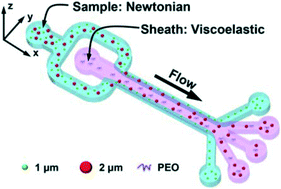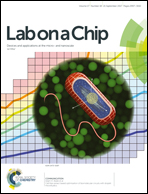Microfluidic co-flow of Newtonian and viscoelastic fluids for high-resolution separation of microparticles†
Abstract
The microfluidic passive control of microparticles largely relies on the hydrodynamic effects of the carrier media such as Newtonian fluids and viscoelastic fluids. Yet the viscoelastic/Newtonian interfacial effect has been scarcely investigated, especially for high-resolution particle separation. Here we report a microfluidic co-flow of Newtonian (water or PBS) and viscoelastic fluids (PEO) for the size-dependent separation of microparticles. The co-flow condition generates a stable viscoelastic/Newtonian interface, giving rise to the wall-directed elastic lift forces that compete with the center-directed lift forces, and efficiently hinders the migration of microparticles from the Newtonian to the viscoelastic fluid in a size-dependent manner. An almost complete separation of a binary mixture of 1 μm and 2 μm polystyrene particles is achieved by the co-flow of water and a very dilute PEO solution (100 ppm), whereas the sole use of water or PEO could not lead to an efficient separation. This co-flow microfluidic system is also applied for the separation of Staphylococcus aureus (1 μm) from platelets (2–3 μm) with >90% efficiencies and purities.



 Please wait while we load your content...
Please wait while we load your content...